



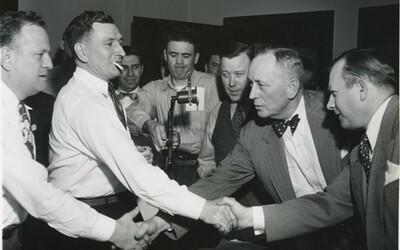
In May 1950, the United Automobile Workers (UAW) and General Motors (GM) signed a five-year contract that was dubbed “The Treaty of Detroit” by Fortune magazine and became a landmark agreement of postwar U.S. labor relations. Importantly, the contract greatly improved workers’ wages, set up a pension plan after 25 years of employment and initiated company-paid healthcare. Renouncing the right to bargain over some issues, the UAW wanted to avoid strikes like the recently ended 104-day Chrysler strike that had left 100,000 Detroiters out of work. The UAW also wanted a contract that would offer extensive benefits to its members. The $1 billion cost of the contract for GM seemed worth it to the manufacturer, since predictable labor costs would help the company “regain control over one of the crucial management functions in any line of manufacturing – long-range scheduling of production, model changes, and tool and plant investment”.
Labor historian Daniel Clark underscores key passages of the accord: “[…] the agreement guaranteed four-cent-an-hour raises each year above increases in the cost of living, and pensions of up to $117 a month, including Social Security, for retirees at age sixty-five. If GM employees were to work regularly, by the end of the contract they would receive over $700 more annually than under the previous agreement. GM also agreed to pay half of the hospital/medical insurance cost for union members; previously, workers paid the entire premium. In addition, the contract called for a modified union shop, in which all new hires at GM plants would have to join the UAW for their first year but could then quit the union if they desired.” In exchange for these allowances, GM wanted a five-year contract, and the UAW acquiesced. Similar conditions were settled with Chrysler and Ford.
 Reuther oversees handshake between UAW and GM
Reuther oversees handshake between UAW and GM
Only a month after the 1950 contract with GM was signed, though, the effects of the Korean War on inflation became very important and the cost-of-living allowance, an essential novelty provided by the contract, could not match record high prices. In his book Walter Reuther and the Rise of the Auto Workers, John Barnard also explains how Reuther requested in 1952 that GM and the other manufacturers reopen the contracts: “Contracts, he said, were “living documents” – a phrase that infuriated executives. If unanticipated events such as wars and inflation, undermined real wages, that was justification for a new agreement to restore the equity originally established. When GM refused, wildcat strikes broke out, and the union did nothing to punish the perpetrators. Grievances that would ordinarily have been settled led to local strikes. Production at GM and Ford nearly came to a standstill. Finally, in May 1953, the union prevailed. GM gave production workers a 10 cent raise with an additional 10 cents for skilled workers, revised the cost-of-living formula upward and increased the base rate, raised the annual improvement factor to 5 cents an hour, improved pensions to $137.50 a month, and arranged group health coverage for retirees.”
Interestingly, while the companies felt were frustrated about the reopening of the contracts, the a precedent was set that would prove beneficial to some of them: “In 1979, Chrysler, compelled by the federal government as the condition of its loan guarantees, successfully reopened its contract with the UAW in order to erase promised wage increases. GM and Ford later demanded and obtained similar relief through negotiations.”
The agreements of 1950 and 1953 are considered landmarks in postwar U.S. labor history because they were first perceived as the testimony of the companies’ recognition of the union’s role as the authorized representative of their workers; an evident sign of the companies’ willingness to foster more stable employment opportunities and better living conditions for their workers through structured wage increases, and various other benefits. However, the agreements also give evidence to the corporations’ firm reluctance to include the UAW in management functions.
In the 1950s, the “Treaty of Detroit” agreement reached with GM spread, in a way, across the unionized sector, serving as a reference beyond labor-management relations in the auto industry. In his entry “Treaty of Detroit and Postwar Labor Accord” featured in the 2013 online version of The Oxford Encyclopedia of American Business, Labor, and Economic History, Kevin Boyle underscores the following: “In industry after industry, labor leaders traded away their claim to a voice in corporate decision making for agreements that gave their members better pay and a widening array of benefits: not only retirement funds and health-care plans but unemployment compensation, paid vacations, and holiday time as well.” More recently, though, scholars have asked whether such a configuration – the idea of a “postwar accord” to which both corporate America and the unions would have been dedicated – was really the most useful paradigm to describe the postwar landscape of labor relations, as Boyle writes: “Even those corporations that did sign agreements on the General Motors model, moreover, undermined workers’ positions in other ways. The most notable example may be the auto industry itself. Throughout the 1950s GM, Ford, and Chrysler helped to offset the cost of their contracts by automating their factories. In the process, production shot up 70 percent, while the workforce shrank by 11 percent. If corporate America was not so committed to a postwar accord as historians had thought, neither were unions so quiescent. Some of the era's most powerful labor leaders—most notably the UAW's longtime president Walter Reuther—continued to insist that the public deserved a voice in corporate decision making. Union-sanctioned strikes were more common in the 1950s and 1960s than in any other period, including the turbulent years of the 1930s.”
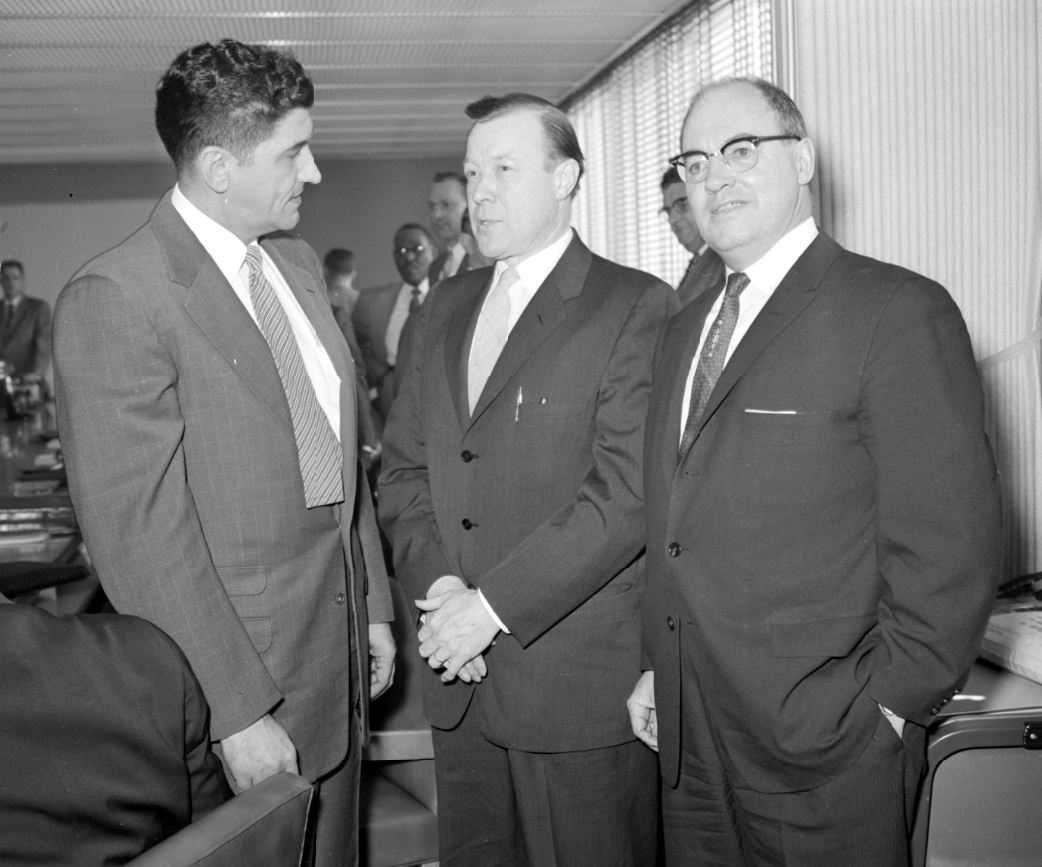 Reuther and labor leaders in 1958 image courtesy of Wayne State University
Reuther and labor leaders in 1958 image courtesy of Wayne State University
Alluding to Nelson Lichtenstein’s book State of the Union: A Century of American Labor, Boyle seems to suggest that the Treaty of Detroit and its emulators could rather be conceived in terms of a “temporary peace” – Lichtenstein uses the work “truce”, as Boyle explains – in the relations between the companies and their workers. In fact, for workers, it seems as though the contracts of the 1950s were not the sign of a guaranteed extended participation in and/or profit from the postwar boom, but rather “efforts to achieve some semblance of stability and predictability in a volatile industry.”
RESEARCH & WRITING
Louise-Helene Filion, Ph.D.
PHOTO RESEARCH
Rebecca Phoenix
Bibliography
John Barnard, Walter Reuther and the Rise of the Auto Workers, Boston and Toronto, Little, Brown and Company, 1983, 236 p.
Kevin Boyle, “Treaty of Detroit and Postwar Labor Accord.” The Oxford Encyclopedia of American Business, Labor, and Economic History – Online Version, https://www.oxfordreference.com/view/10.1093/acref/9780199738816.001.0001/acref-9780199738816-e-518?rskey=G8jttc&result=1 . Accessed 27 January 2022.
Daniel Clark, Disruption in Detroit: Autoworkers and the Elusive Postwar Boom, Urbana, Chicago and Springfield, University of Illinois Press, 2018, 243 p.
Nelson Lichtenstein, State of the Union: A Century of American Labor, Princeton, N.J., Princeton University Press, 2002, 336 p.
Stephen Meyer, “An Economic ‘Frankenstein’: UAW Workers’ Response to Automation at the Ford Brook Park Plant in the 1950s.” Automobile in American Life and Society, Science and Technology Studies Program at the University of Michigan-Dearborn and Benson Ford Research Center (The Henry Ford), 2004-2010, http://www.autolife.umd.umich.edu/Labor/L_Casestudy/L_casestudy5.htm . Accessed 27 January 2022.
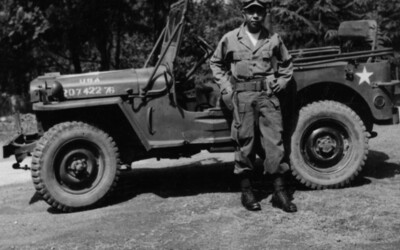
After a record production year in 1950, manufacturing was restricted in the passenger car industry because the US government wanted to prioritize scarce materials like steel and copper, among others, for defense production in the context of the Korean “police action.” The beginning of the Korean War affected all the automakers. Production quotas were imposed, as the industry accepted military contracts. Vehicle production dropped by 1,300,000 units in 1951 in comparison to 1950. With automakers also facing price controls, production diminished by another million in 1952. In 1953, after the government withdrew production quotas (in March), and output rose impressively over to six million units. However, independent automakers produced 300,000 cars less than in 1950, the previous year in which 6,000,000 cars were built. The impacts of two wars and the importance of the Big Three are reflected in these statistics.
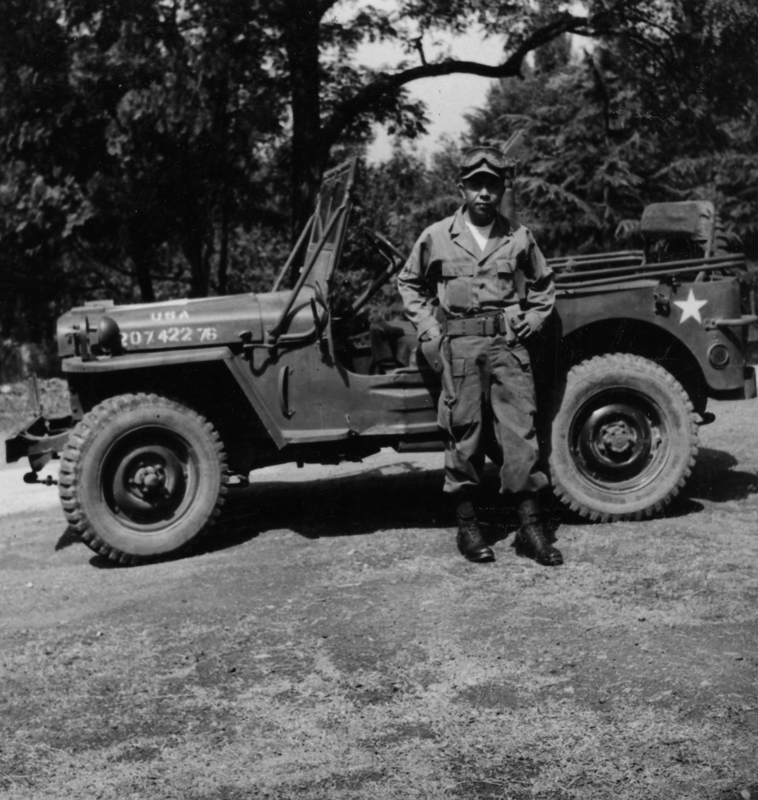 Seargeant Diale standing by Gen. Frank E. Lowes Jeep 1950 image courtesy of Harry Truman Library
Seargeant Diale standing by Gen. Frank E. Lowes Jeep 1950 image courtesy of Harry Truman Library
During the Korean War, the National Production Authority did take measures to support the independant automakers, who were less in a position to counterbalance their losses by engaging in military production: but even with the help of the National Production Authority, who gave a larger part of the car production quota to independents such as Willys-Overland and Nash, independent carmakers were significantly affected by the Korean conflict building 35% less cars in 1953 than their peers had done in 1950.
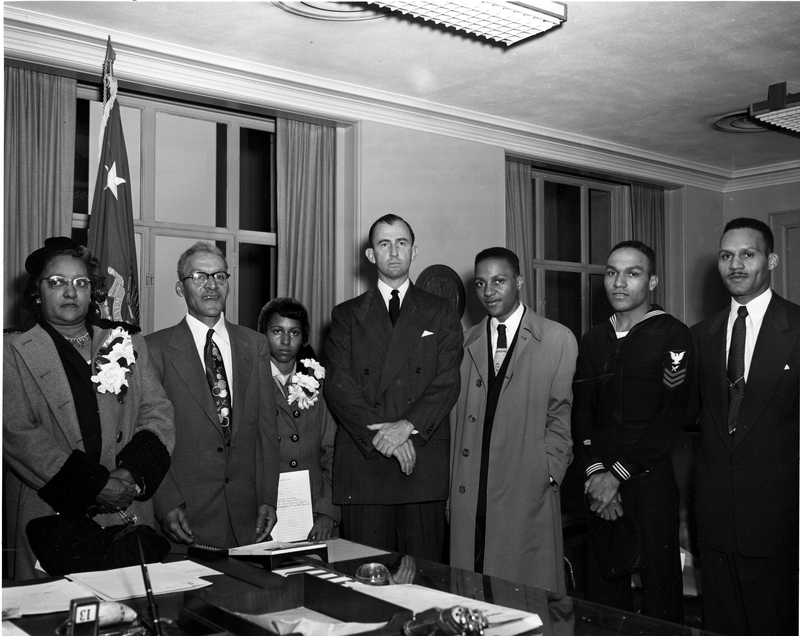 Family of Sergeant Cornelius H. Carleton 1952 image courtesy of Harry S. Truman Library
Family of Sergeant Cornelius H. Carleton 1952 image courtesy of Harry S. Truman Library
Once the Korean situation had been stabilized and government controls were removed in March 1953 an intense battle began among the Big Three for market share, arising partly from the Ford management’s wish to outproduce Chevrolet. A buyer’s market once again emerged, with all makes being readily available since the manufacturers, especially the Big Three, were able to produce the quantity of cars they wanted to satisfy buyers’ demands. The end of the Korean war also introduced rivalries in terms of automotive styling, rapid changes in car models and a rapid increase in terms of the number of available car models.
RESEARCH & WRITING
Louise-Helene Filion, Ph.D.
PHOTO RESEARCH
Rebecca Phoenix
Sources:
-Smith, Philip Hillyer. Wheels within Wheels. A Short History of American Motor Car Manufacturing. New York, Funk & Wagnalls, 1968, especially p. 149-151.
-Edwards, Charles E. Dynamics of the United States Automobile Industry. Columbia (S.C.), University of South Carolina Press, 1965, especially p. 16-17, and p. 28-29.
-White, Lawrence J., The Automobile Industry since 1945. Cambridge (Mass.), Harvard University Press, 1971, especially p. 126 and p. 201.